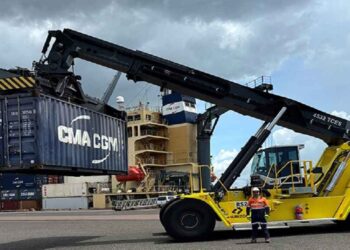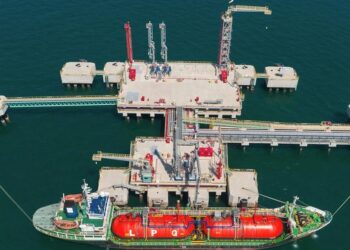Qatar is currently constructing a new container port located between the municipalities of Al Wakrah and Mesaieed. The new port is set to replace the existing Doha Port when the first phase starts operating in early 2016, with an initial cargo handling capacity of two million TEU.
The initial idea to construct the port was announced in June 2007. The environmental permit for the construction of the port has been realised and the construction works began in October 2011. The first concrete for the port’s quay wall was laid in July 2012.
It is considered to be the largest port development project in the world to be built on unused land. It is expected that it will require an investment of QAR 27bn ($7.4bn).
The New Port Project (NPP) will also comprise of constructing a new naval base for the Qatar Emiri Naval Forces and the Qatar Economic Zone 3 (QEZ3) Canal.
The whole project site covers an area of about 26.5 square kilometres. The naval base alone will cover an area of 4.5 square kilometres. The port will have a capacity of six million TEU per annum and will be capable of handling the largest container vessels in the world.
Benefits of the New Port Project (NPP)
The New Port Project (NPP) forms part of the Qatar National Vision 2030 which aims at converting Qatar into a developed country by 2030.
The port will ease the import of goods, which will enable other development projects in Qatar to be realised, as the country prepares to host the FIFA World Cup in 2022.
The port will be capable of handling general cargo, bulk grain, livestock and vehicle traffic. It will also feature state-of-the-art facilities to handle the largest cargo vessels, cruise vessels, coastguard vessels and a marine support unit.
The port will feature three container terminals, each with a handling capacity of two million TEUs per annum. It will be linked to the proposed Gulf Cooperation Council (GCC) rail network, linking the port to the six GCC countries including Qatar, Oman, UAE, Saudi Arabia, Kuwait and Bahrain.
Constructing Qatar’s new shipping hub
The access channel covering an area of 20 square kilometres is currently being dredged. Two outer breakwaters and and two inner breakwaters will also be constructed. The materials recovered from the dredging of the 15m deep access channel will further be used for the construction of the 4.5 square kilometres naval base which will be located offshore.
The QZE3 Canal will cover an area of two square kilometres. It will act as a major economic hub and boost the export and imports of goods at the airport.
The dredging works are being carried out using two self-propelled rock cutter suction dredgers. The dredging materials will be transferred using about 500 dump trucks for the relocation of the naval base.
The 8.5km quay wall is expected to utilise more than 35,000 concrete blocks weighing in the range of 40t to 90t.
The construction work will witness the excavation and rockblasting of about 70 million cubic metres of material.
Other associated works will include construction of roads, water supply and building infrastructure.
Contractors involved with the new container port
The programme management services for the project are being provided by AECOM. The contract valued $149m was awarded in November 2008. A further $58.8m contract was awarded to the company two years later to undertake additional works.
A $35m contract for the design and master plan of the port was awarded to WorleyParsons, which in turn subcontracted Royal Haskoning to assist in the port design.
The dredging work for the access channel is being carried out by Middle East Dredging Company (MEDCO). The $1.23bn contract, which is being financed by Qatar Islamic Bank (QIB), will also involve the execution of the dredging works for the basin, reclamation for the naval base and construction of the two outer breakwaters.
The construction of the port basin, the quay walls and the inner breakwaters is being undertaken by China Harbour Engineering Company (CHEC).
Telleborg has been contracted to supply 829 fender systems, 606 bollards and ladders for the project.
The mitigation works, including the relocation of approximately 10,000 hard coral locations within the project site, have been assigned to CSA International.































